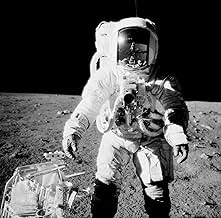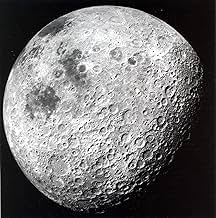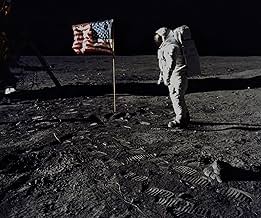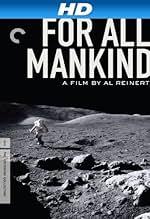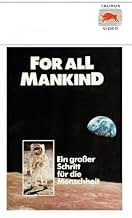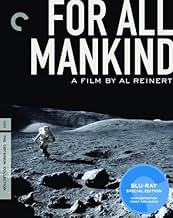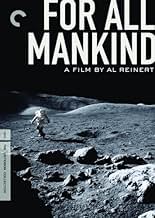An in-depth look at various NASA moon landing missions, starting with Apollo 8.An in-depth look at various NASA moon landing missions, starting with Apollo 8.An in-depth look at various NASA moon landing missions, starting with Apollo 8.
- Nominated for 1 Oscar
- 3 wins & 3 nominations total
Jim Lovell
- Narrator - Apollo 8, Apollo 13
- (voice)
- (as James A. Lovell Jr.)
Ken Mattingly
- Narrator - Apollo 16
- (voice)
- (as T. Kenneth Mattingly II)
Russell Schweickart
- Narrator - Apollo 9
- (voice)
- (as Russell L. Schweickart)
Eugene Cernan
- Narrator - Apollo 10, Apollo 17
- (voice)
- (as Eugene A. Cernan)
Charles Conrad
- Narrator - Apollo 12
- (voice)
- (as Charles P. Conrad Jr.)
Richard Gordon
- Narrator - Apollo 12
- (voice)
- (as Richard F. Gordon Jr.)
Alan Bean
- Narrator - Apollo 12
- (voice)
- (as Alan L. Bean)
Jack Swigert
- Narrator - Apollo 13
- (voice)
- (as John L. Swigert Jr.)
Stuart Roosa
- Narrator - Apollo 14
- (voice)
- (as Stuart A. Roosa)
James Irwin
- Narrator - Apollo 15
- (voice)
- (as James B. Irwin)
Charles Duke
- Narrator - Apollo 16
- (voice)
- (as Charles M. Duke Jr.)
Harrison Schmitt
- Narrator - Apollo 17
- (voice)
- (as Harrison H. Schmitt)
Buzz Aldrin
- Self
- (archive footage)
Bill Anders
- Self
- (archive footage)
Neil Armstrong
- Self
- (archive footage)
Stephen Bales
- Self
- (archive footage)
- (as Steve Bales)
Frank Borman
- Self
- (archive footage)
Featured reviews
I've been a fan of Brian Eno's work for years, and have cherished the album entitled "Apollo: Atmospheres and Soundtracks." The album is the commissioned soundtrack for this compilation documentary of the NASA Apollo missions. What a harmony of the arts this is. The stark NASA footage coupled with the hauntingly soothing score create a fascinating marriage of techniques and styles. Although the music editor overused certain tracks over others, the subtlety of Eno's music prevents it from becoming repetitive. A pleasure to watch.
This film is a retelling of arguably one of the greatest achievements of the human race. In summer 1969, on a bright sunny morning, a group of astronauts led by commander Neil Armstrong climbed into the Saturn V rocket ready for its first flight. Not even 70 years had passed since planes had been invented. About 1 million people had gathered at the Kennedy Space Center in Florida to witness the once in a lifetime event, and millions more watched the entire thing on television. This film attempts to recapture some of that excitement that must have been everywhere on that day. It features interviews with the people who were brave enough to leave Earth in order to visit a place that has always watched over humanity, quite literally. At some points, it feels almost like a horror movie because nobody in the rocket or back on Earth knew if the thing would just blow up in flight for no reason, and the inside of the rocket module looks incredibly small. One of the astronauts says how strange of an experience it was and how going to the moon isn't like travelling to any other place, because when you travel somewhere, you have various landmarks to tell how far you got. On the moon mission, he says you leave Earth, pass an unimaginably large area of absolutely nothing for a few days, and suddenly, you're at the moon. There is nothing in between. The fact that the moon is only about a quarter of a million miles from Earth while stars are so far away you couldn't reach them even if you travelled your whole life makes it even more daunting. After the module lands on the surface, Neil says his famous line, and we see more very impressive shots of what the surface of the moon looks like. It has a depressing feel to it because the only colors are gray and black, but at the same time, it has a triumphant feel. The moon has been waiting thousands of years for people to go there, and the men reflect this by saying even though they knew they might not come back, they felt at home there. The soundtrack for this movie also gives it a sad feel that makes you realize how vast and empty space is. They show many things that seem unbelievable, even to experienced astronauts, such as small dots of light on the African continent (they're actually fires started by tribes), and having their food float in zero gravity when they're trying to eat. This is something that everyone should see at least once, because it discusses one of humanity's biggest accomplishments. To this day it's strange to think it was done in the 60s. Not many people have been to space, so you will be amazed watching this.
I taped this off British TV in 1989 or 1990, and could never understand why nobody I speak to has ever heard of it! Even real space enthusiasts have not seen or heard of this wonderful film. Even today it remains unavailable on DVD except in the USA (buy an import from Amazon, well worth it!).
Quite simply there is no better way to tell the story of such a unique and special journey than in the words of those who undertook it. Here we have the live radio transmissions between the astronauts and Houston, reminiscences from the astronauts a decade or so after and no interference from any professional actor/narrator. There is footage even the most obsessed space enthusiast will not have seen, especially the 8mm film shot by the astronauts themselves.
This film presents, in a mere 80 minutes, the story of the Apollo missions from pre-launch preparations though the journey, their time on the surface of the moon to the take-off from the moon and safe return to earth. The views are as majestic as any on the earth, all accompanied by soft and appropriately ethereal music.
Why this hidden gem of a film is not constantly being broadcast on a documentary channel or even entertainment stations is totally beyond me - and also beyond those I have shared the DVD with. Seek out this film and watch it. As a friend said to me, "why is it we can walk into any shop and buy row upon row of rubbish and we cannot buy this, which shows a real achievement of mankind".
Quite simply there is no better way to tell the story of such a unique and special journey than in the words of those who undertook it. Here we have the live radio transmissions between the astronauts and Houston, reminiscences from the astronauts a decade or so after and no interference from any professional actor/narrator. There is footage even the most obsessed space enthusiast will not have seen, especially the 8mm film shot by the astronauts themselves.
This film presents, in a mere 80 minutes, the story of the Apollo missions from pre-launch preparations though the journey, their time on the surface of the moon to the take-off from the moon and safe return to earth. The views are as majestic as any on the earth, all accompanied by soft and appropriately ethereal music.
Why this hidden gem of a film is not constantly being broadcast on a documentary channel or even entertainment stations is totally beyond me - and also beyond those I have shared the DVD with. Seek out this film and watch it. As a friend said to me, "why is it we can walk into any shop and buy row upon row of rubbish and we cannot buy this, which shows a real achievement of mankind".
Great footage, but the missions are all over the place without really telling us. If you don't have a little knowledge beforhand, like Apollo 13, you're pretty much left in the dark which mission is which and may think it was just 1 mission to the moon (and back obviously). Started to really dawn on me when Apollo 13 had that breathing problem (which was solved in a jiffy in this documentary) and then a crew was going for a moonlanding ( which obviously Appolo 13 never did. But hey when you hear the name Neil Armstrong you are pretty much back on course. Ah okay great i am seeings Apollo 11 and the first moonlanding at the moment : )
Footage: 8.5 Overall Docu : 6.
Footage: 8.5 Overall Docu : 6.
In a project almost more ambitious than the Apollo program itself, Al Reinert distills six million feet of NASA film footage and over 80 hours of taped interviews into a glorious 90- minute flashback to the ultimate achievement of our time: the manned exploration of another world. The film condenses all ten Apollo moon shots into a single flight, using only the genuine sights, sounds, and impressions experienced by the astronauts themselves along the way, from the tension and exhilaration of lift off to the joy (and inconvenience) of zero gravity, and from the loneliness of deep space to the wonder of stepping foot on an alien world. Seeing the footage for the first time on a big screen can be a revelation; it's a thrilling, vicarious journey across a new threshold in human evolution, providing both an argument for the continued human exploration of the cosmos and a timely reminder of how precious life on our own planet is.
Did you know
- TriviaThe staging footage was captured because NASA wanted to document the flight process of an unmanned Saturn flight for feedback in case there was a failure for engineers to look at footage to see what went wrong. Cameras were mounted in strategic locations, kicking on at critical moments to document the staging process for less than half a minute. After completion, the light-tight canisters containing the exposed film were jettisoned, dropping to earth with homing beacons and parachutes inside protective heat shields. Air Force C-130 transport planes, towing gigantic nets, recovered the canisters in the southern Atlantic Ocean.
- GoofsThe opening of the documentary incorrectly states that: "During the four year between December 1968 and November 1972, there were nine manned flights to the moon." The last lunar mission, Apollo 17, took place in December 1972.
- Quotes
Charles M. Duke Jr.: The only bad part about zero gravity in Apollo was goin' to the bathroom. We had a very crude system. For your feces it was a bag, and you put this bag in the right position. So you go, but the only thing is that nothing goes to the bottom of the bag in zero gravity.
- Crazy creditsFilmed on location by the United States National Aeronautics and Space Administration.
- SoundtracksSirens
Courtesy of Opal Records (Music For Films III)
Written and Performed by Daniel Lanois and Brian Eno
Licensed by Upala Music/Hamstein (BMI)
- How long is For All Mankind?Powered by Alexa
Details
- Release date
- Country of origin
- Language
- Also known as
- National Geographic: For All Mankind
- Filming locations
- Sea of Tranquility, The Moon, Space(Apollo 11 landing site)
- Production companies
- See more company credits at IMDbPro
Box office
- Gross US & Canada
- $770,132
- Opening weekend US & Canada
- $33,777
- Nov 5, 1989
- Gross worldwide
- $770,366
- Runtime
- 1h 20m(80 min)
- Color
- Sound mix
- Aspect ratio
- 1.37 : 1
Contribute to this page
Suggest an edit or add missing content



